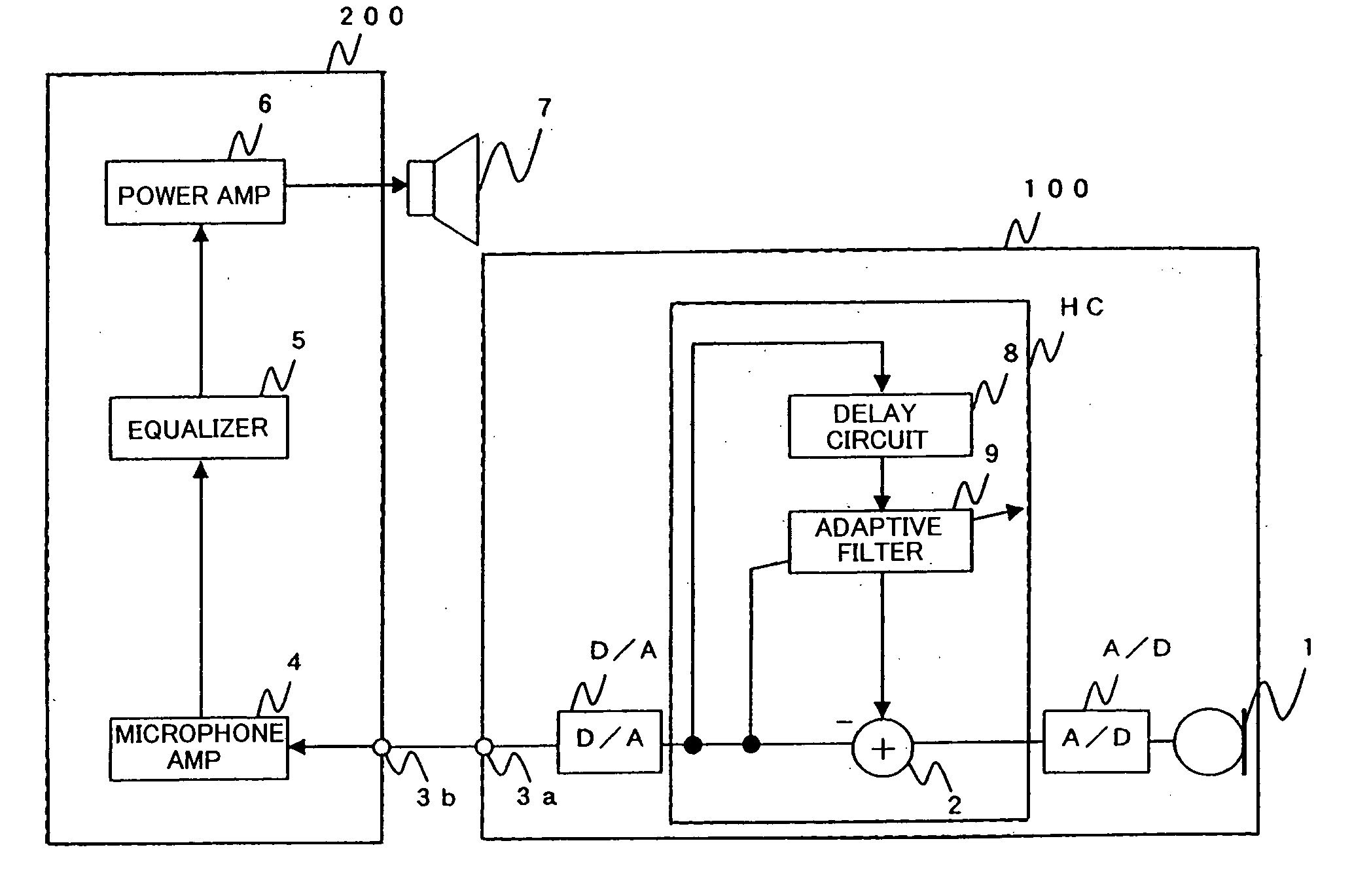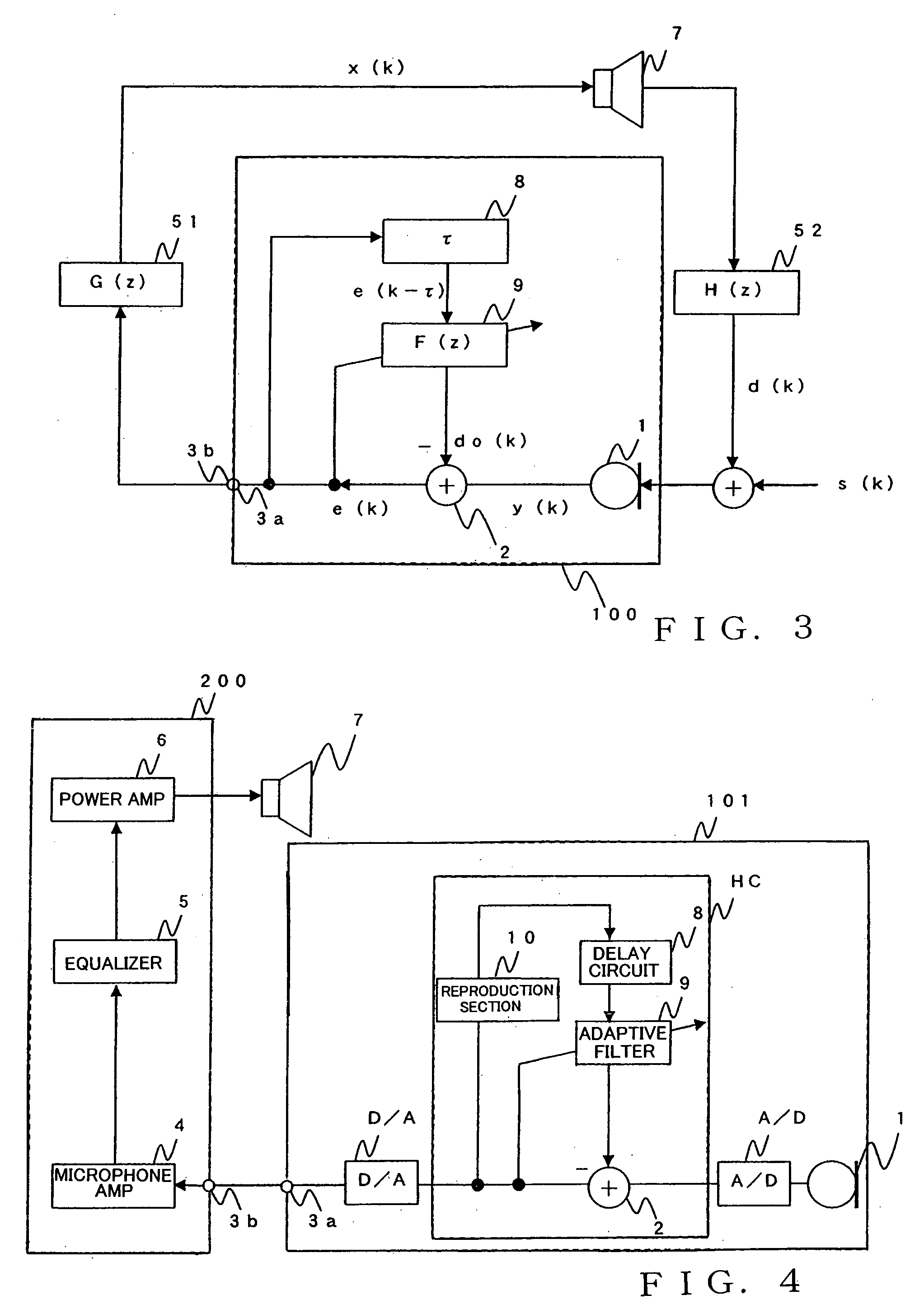Microphone and sound amplification system
a technology of sound amplification and microphone, applied in the field of microphones, can solve the problems of increasing cost, difficult to effectively cancel the disclosed howling canceller, and difficult to incorporate the howling canceller into an existing amplifier device, and achieve the effect of reliable cancellation of howling
- Summary
- Abstract
- Description
- Claims
- Application Information
AI Technical Summary
Benefits of technology
Problems solved by technology
Method used
Image
Examples
first embodiment
[0044]FIG. 1 is a block diagram of a sound amplification apparatus in accordance with a first embodiment of the present invention. As shown, the sound amplification apparatus comprises: a microphone 100 including a sound-collecting microphone element 1, A / D converter, howling canceller HC, D / A converter and connecting terminal 3a; an amplifier device 200 including a connecting terminal 3b, microphone amplifier 4, equalizer 5 and power amplifier 6; and a speaker 7. Note that a microphone amplifier may be provided between the microphone element 1 and the A / D converter, in which case the amplifier device 200 need not include the microphone amplifier 4.
[0045] The howling canceller HC includes an adder 2 between the A / D converter and the D / A converter, an adaptive filter 9 for supplying a simulative feedback signal to the adder 2, and a delay circuit 8 for delaying a residual signal, output from the adder 2, by a predetermined time and supplying the thus-delayed residual signal to the a...
second embodiment
[0062]FIG. 4 is a block diagram of a sound amplification apparatus in accordance with a second embodiment of the present invention. In FIG. 4, the same components as in the first embodiment are indicated by the same reference characters and will not be described in detail here to avoid unnecessary duplication. The sound amplification apparatus according to the second embodiment includes, in place of the microphone 100 in the first embodiment, a microphone 101 where a reproduction section 10 is connected to the path between the adder 2 and the delay circuit 8.
[0063] The reproduction section 10 is implemented by a digital filter (simulating amplifier filter) that filters the output signal from the adder 2 and outputs the thus-filtered signal to the delay circuit 8. Transfer function of the reproduction section 10 is determined in advance assuming an ordinary sound amplification apparatus or the like. Thus, each signal input to the delay circuit 8 approximates a signal actually transf...
fourth embodiment
[0085]FIG. 10 is a block diagram of a sound amplification apparatus in accordance with a fourth embodiment of the present invention. In FIG. 10, the same components as in the first embodiment are indicated by the same reference characters and will not be described in detail here to avoid unnecessary duplication. As shown, the sound amplification apparatus according to the fourth embodiment includes a microphone 104 provided with a signal receiver section 21 connected to the delay circuit 8, and an amplifier unit 204 provided with a signal transmitter section 20 connected between the power amplifier 6 and the speaker 7.
[0086] The signal transmitter section 20 acquires each signal to be transferred to the speaker 7 and transmits the acquired signal to the signal receiver section 21 of the microphone 104. The signal to be transferred to the speaker 7 after having been received by the signal receiver section 21, is converted via the A / D converter into a digital signal, and the thus-con...
PUM
 Login to View More
Login to View More Abstract
Description
Claims
Application Information
 Login to View More
Login to View More - R&D
- Intellectual Property
- Life Sciences
- Materials
- Tech Scout
- Unparalleled Data Quality
- Higher Quality Content
- 60% Fewer Hallucinations
Browse by: Latest US Patents, China's latest patents, Technical Efficacy Thesaurus, Application Domain, Technology Topic, Popular Technical Reports.
© 2025 PatSnap. All rights reserved.Legal|Privacy policy|Modern Slavery Act Transparency Statement|Sitemap|About US| Contact US: help@patsnap.com



